Dogs, our beloved four-legged companions, come in many shapes and sizes. Still, two breeds are truly remarkable: the gentle Newfoundland dog and the energetic Siberian husky. Each breed possesses its unique appeal, capturing the hearts of dog lovers worldwide.
The Newfoundland dog is a tender-hearted guardian. It has an imposing stature and a calm demeanor winning over everyone it meets. This colossal, yet gentle creature stands tall, watching over its human companions with unwavering devotion. In contrast, the Siberian husky’s energy and agility are unmatched. This lively explorer has a keen sense of adventure, a dense coat, and is a delight to all who cross its path.
Join us to embark on a fascinating exploration of the unique qualities that distinguish the Newfoundland and Siberian husky breeds. This comprehensive comparison delves into 9 key differences that shape their personalities, appearances, and temperaments.
From their origins and size to their coat types and exercise needs, uncover the intriguing contrasts that define these beloved canine companions. Whether you’re considering adding a gentle giant or an energetic dog to your family, understanding these distinctions will guide you toward the perfect match for your lifestyle and preferences.
History of Newfoundland
The Newfoundland’s history is still a mystery, much like a foggy day at sea, even though it comes from the province of the same name in Canada. Here are three intriguing theories in an attempt to unravel its origins.
One theory suggests Newfoundland emerged from a cross between the Tibetan mastiff and the now-extinct American black wolf. Another point is that Vikings left dogs behind during their New World visit, which interbred with eastern Canadian wolves. The third theory proposes a blend of European breeds, including Pyrenean sheep dogs, mastiffs, and Portuguese water dogs.
During the late 18th century, renowned English botanist Sir Joseph Banks became the proud owner of multiple Newfoundlands, which were aptly named by George Cartwright. However, government-imposed dog taxes in the 1780s pushed the breed to extinction. Sir Edwin Landseer, an artist captivated by the breed, painted them extensively, leading to the naming of the white and black variety after him.
Honorable Harold MacPherson, governor of Newfoundland, championed the breed, ensuring its survival. The Newfoundland first graced England in 1860, and the American Kennel Club in 1879, standing tall as a symbol of resilience and adaptability.
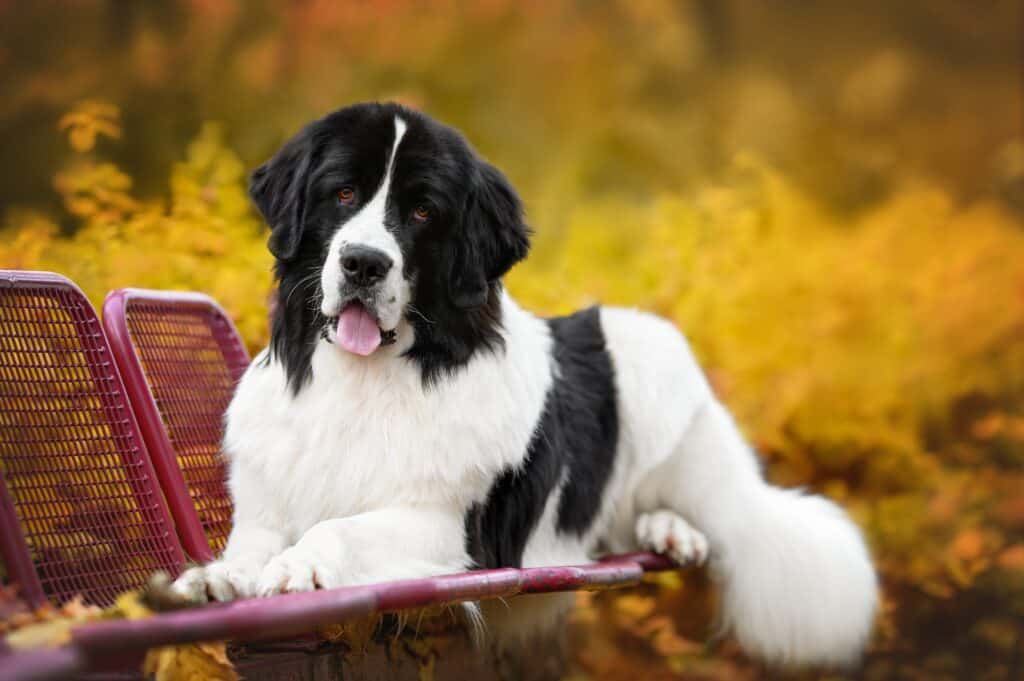
Sir Edwin Landseer, an artist captivated by the breed, painted Newfoundland dogs extensively, leading to the naming of the white and black Landseer variety after him.
©Otsphoto/Shutterstock.com
History of Siberian Husky
The Siberian husky’s distinctive features – well-furred coat, compact body, upright ears, and thick, sickle-shaped tail – vividly depict its northern heritage. Bred in northeastern Asia by the Chukchi people, these dogs served as family companions and endurance sled dogs.
As the climate changed, the Chukchi faced a choice: adapt or perish. They took on the challenge and succeeded in creating a sled dog that could travel through huge, freezing wastelands with little effort. Thus, the lineage of today’s Siberian husky was established, tracing its origins back to those early predecessors.
The breed captured public attention in the early 1900s when they began winning sled races. However, the heroic 1925 serum run, led by legendary musher Leonhard Seppala, truly solidified their fame.
Racing 658 miles in just five and a half days, Seppala’s team of Siberian huskies delivered lifesaving serum to diphtheria-stricken Nome, Alaska. Seppala’s lead dog, Balto, became a canine hero, immortalized with a statue in New York City’s Central Park.

Siberian huskies were historically used for sledding and transportation in cold regions.
©iStock.com/Elayne Massaini
Newfoundland vs. Siberian Husky: A Comparison
When deciding between the Newfoundland and Siberian husky, potential pet owners should consider each breed’s unique physical traits, demeanor, and overall needs. Let’s look at the key differences between these two popular dog breeds:
Appearance
Height
The height difference between the Siberian husky and Newfoundland is noticeable and contributes to their distinct appearances. With their elegant frames, Siberian huskies stand between 20 to 24 inches (51 to 61 cm) tall, making them a medium-sized breed.
In contrast, the massive Newfoundland, known for its gentle and patient nature, towers at 26 to 28 inches (66 to 71 cm), placing it in the large breed category. This significant difference in height helps potential dog owners choose the right breed based on their living space and lifestyle preferences.
Weight
A substantial disparity in weight also exists between these two breeds, further emphasizing their contrasting physical characteristics. A Siberian husky typically weighs between 35 to 60 pounds (16 to 27 kg), showcasing a lean and athletic build well-suited for agility and endurance activities.
On the other hand, Newfoundland’s considerable size results in a weight range of 100 to 150 pounds (45 to 68 kg), highlighting its powerful presence and capacity for heavy work, such as water rescue or pulling carts.
Coat
Distinct coat colors, patterns, and textures also set these breeds apart. The Siberian husky’s coat comes in different shades. These include gray, tan, black, and white, often featuring unique head markings like a cap, mask, or spectacles. This breed’s double-layered coat provides effective insulation against cold temperatures, making it an excellent choice for colder climates.
Conversely, the Newfoundland sports a heavy, oily coat that efficiently protects it from harsh weather conditions and cold water. This breed’s double coat is water-resistant, which helps keep the dog warm and dry even when swimming or working in wet environments.
Newfoundland dogs come in colors such as black, brown, gray, and Landseer (a combination of black and white). This breed’s coat is practical and adds to its majestic appearance, contributing to its reputation as a gentle giant.
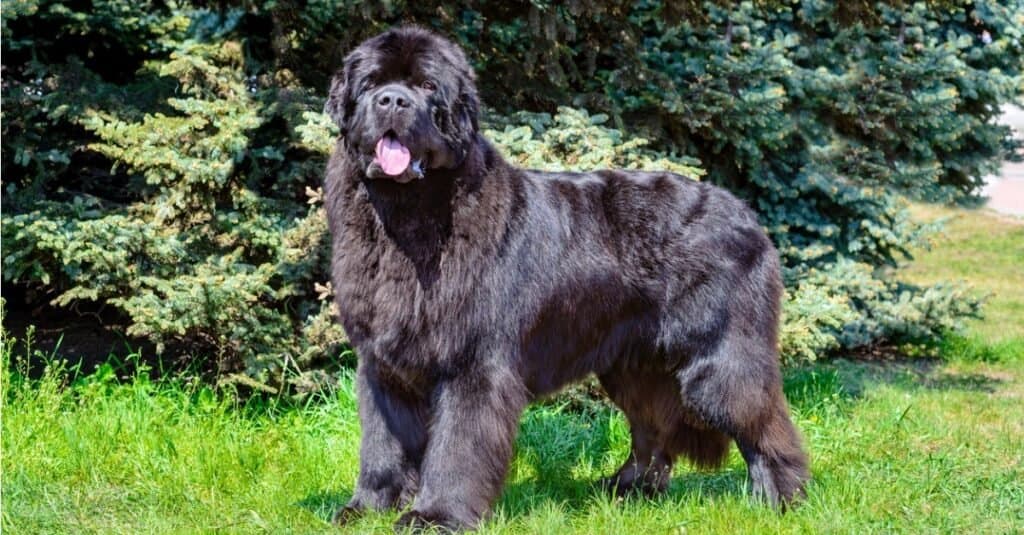
The massive Newfoundland, known for its gentle and patient nature, towers at 26 to 28 inches.
©iStock.com/volofin
Characteristics
Temperament: Newfoundland
Newfoundland dogs are calm, easygoing, and affectionate giants. They interact playfully with almost everyone, including strangers, other dogs, and household pets. Their excellent rapport with children has earned them the nickname “nanny dog.” Eager to please but somewhat slow to respond, these dogs are among the more trainable giant breeds.
As effective protection dogs, their friendly demeanor makes them suitable for all ages. However, their size and strength can be challenging for children and older adults. Keep in mind that individual Newfoundland dog behavior may vary.
Temperament: Siberian Huskies
Siberian huskies exhibit active, independent, mischievous, and playful temperaments. They generally get along well with other dogs, pets, and strangers. However, their friendly nature disqualifies them as ideal guard dogs.
While they enjoy the company of people of all ages, their independence and strength make them less suitable walking companions for children or older people. Siberians are strong-willed and can be challenging to train.
Though not prone to barking, they express themselves through various woos, chirps, and howls. Remember that these descriptions are generalizations, and the behavior of individual Siberian huskies may differ.
Care and Upkeep
Care and Upkeep: Siberian Husky
True to their sled-racing heritage, Siberian huskies require one to two hours of daily exercise. Activities like dog sledding, skijoring, and bikejoring suit them well. These dogs could be better swimmers or retrievers. Training should occur on a leash or in a secure area, as they tend to roam.
A secure yard prevents escape attempts, as they are known for their cleverness. Leaving a Siberian husky alone for long periods or without adequate exercise can result in destructive behavior. They thrive in cold weather but may overheat in hot conditions.
Weekly brushing is necessary, with increased frequency during shedding season. Baths are only needed several times a year.
Care and Upkeep: Newfoundland
Due to their size, Newfoundlands demand a higher cost, effort, and facilities commitment. The expenses of food, medication, surgeries, boarding, and bedding will be higher. A spacious home and vehicle are necessary to accommodate them. Although they prefer cold, hard surfaces, soft bedding helps prevent bursas and calluses.
These gentle giants don’t need extensive exercise; moderate walks or short play sessions suffice. They enjoy swimming, pulling, and cold weather but aren’t suitable for hot climates. Activities such as carting, water rescue, and nose work are recommended.
Newfoundlands shed and drool significantly, making them unsuitable for fastidious housekeepers. Weekly brushing and occasional bathing help maintain their coat, while daily grooming may be required during shedding seasons.
The breed’s lifespan averages 9-10 years and is prone to gastric torsion volvulus and hip dysplasia. Feeding large-breed puppy food can help slow growth and reduce the risk of hip dysplasia.
Trainability
Trainability is one of the key differences between a Newfoundland and a Siberian husky. Newfoundland dogs are known for their intelligence and are easy to train. They have excellent problem-solving skills, making them ideal for tasks such as pulling nets for fishermen or hauling wood.
On the other hand, Siberians are intelligent but independent and stubborn, requiring firm, gentle training from puppyhood.
Newfoundlands mature slower than other breeds, so they need more patience and consistency in training. Conversely, Siberians learn quickly but may need more reinforcement to focus on tasks.
Positive reinforcement and reward-based training techniques are effective with both breeds. Regarding obedience training, Newfoundlands excel in activities such as agility and tracking. In contrast, Siberians excel in activities such as sledding and weight-pulling.
- Both breeds can be trained for basic commands such as sit, stay, come, heel, and down. However, Newfoundlands tend to be more responsive to commands than Siberians due to their higher level of intelligence.
- Both breeds are intelligent and can be trained with patience and consistency. The critical difference between them is their trainability: Newfoundlands are easier to train due to their higher level of intelligence, while Siberians require more reinforcement to stay focused on tasks.
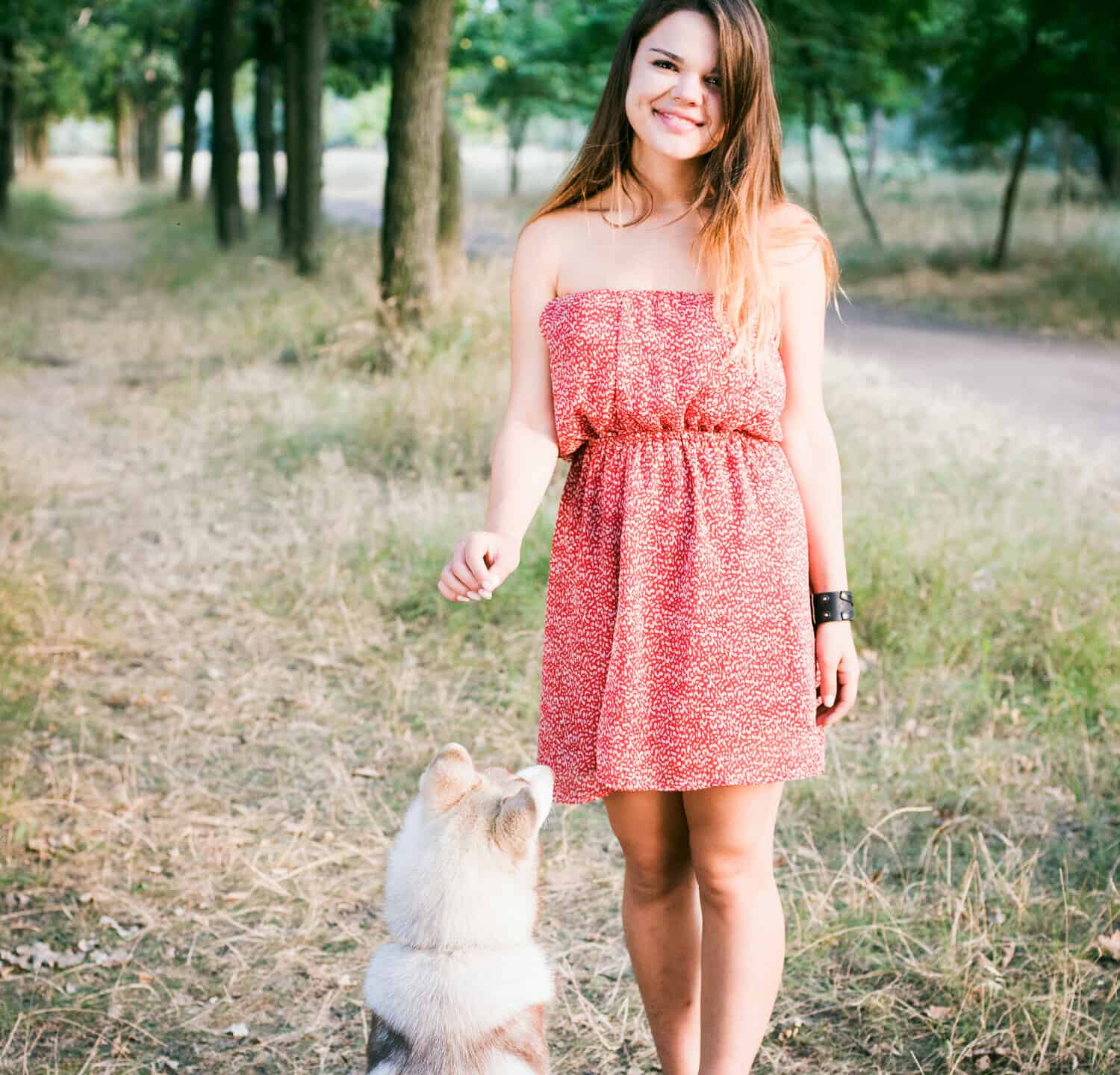
Siberian huskies require more reinforcement to stay focused on tasks.
©Maples Images/Shutterstock.com
Health Factors
Health Factors: Newfoundland
Newfoundlands may encounter health issues such as:
- Ear infections
- Hip and elbow dysplasia
- Heart problems
- Cystinuria (causing kidney and bladder stones)
Although not all Newfoundlands develop these conditions, awareness is crucial. When selecting a puppy, choose a reputable breeder who offers health clearances for both parents, verifying they’ve been tested and cleared of specific issues.
Health Factors: Siberian Husky
Siberian huskies can face health problems such as:
- Hip dysplasia
- Eye disorders
- Autoimmune diseases
It’s also essential to be aware of potential health risks in this breed. Ensure you select a responsible breeder who provides health clearances for the puppy’s parents, confirming they’ve been tested and cleared for known conditions.
Life Expectancy
Life Expectancy: Newfoundland
Newfoundlands have a life expectancy of 8-10 years. Ensuring proper care, nutrition, and regular vet visits helps extend their lifespan.
Life Expectancy: Siberian Husky
In contrast, Siberian huskies live longer, averaging 12-14 years. Prioritizing good health practices contributes to their extended life expectancy.
Working Roles
Working Roles: Newfoundland
Newfoundlands, originally bred as working dogs, have a rich history in water rescue. Their strong swimming abilities, muscular build, and water-resistant coats made them invaluable assets for fishermen and rescue teams.
In today’s world, Newfoundlands continue participating in water rescue activities and competitions, even serving as therapy dogs. Their calm and gentle temperament also makes them ideal family pets, providing love and support to their human companions.
Working Roles: Siberian Husky
Siberian huskies, native to Siberia, were bred as sled dogs to assist the nomadic Chukchi people. Their exceptional endurance, strength, and ability to withstand harsh climates enabled them to pull heavy loads over long distances.
In contemporary society, Siberian huskies still participate in sled racing events and various winter sports, demonstrating their athletic capabilities. Thanks to their friendly and outgoing personality, they are also increasingly popular as family pets.
Comparing Roles in Modern Society
In today’s world, Newfoundland and Siberian husky breeds maintain their traditional roles while adapting to new tasks. Newfoundlands serve in water rescue teams, participate in dog sports, and work as therapy dogs. Siberian huskies compete in sled races, participate in winter sports, and excel in agility and obedience.
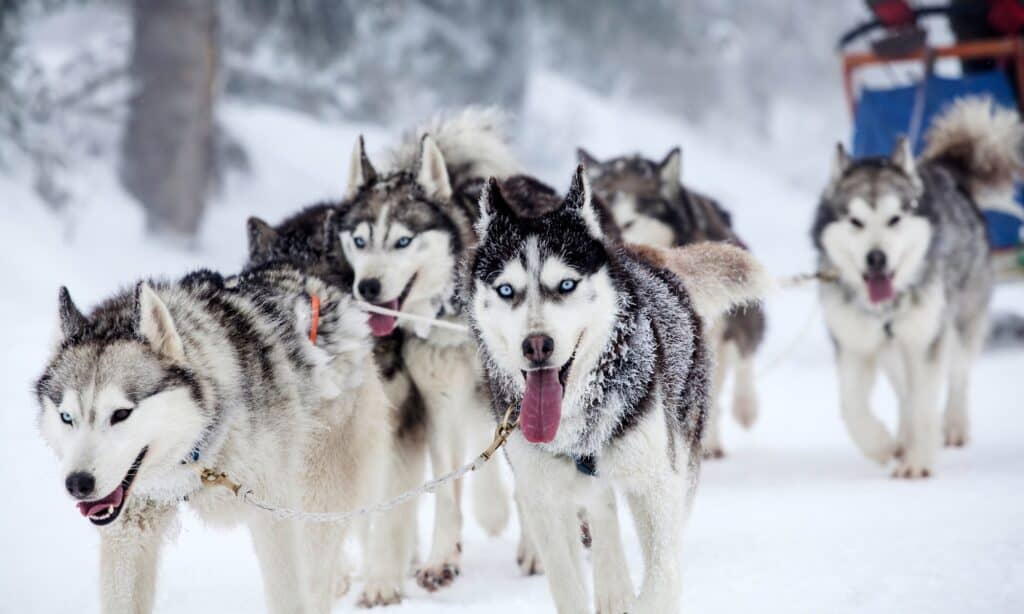
Siberian huskies compete in sled races, participate in winter sports, and excel in agility and obedience.
©iStock.com/8213erika
Living Environment
Living Environment: Newfoundland
Newfoundlands are known for their adaptability to various living situations, making them an excellent choice for urban and rural settings. Despite their large size, these gentle giants can thrive in apartments or houses with small yards as long as they receive adequate exercise and mental stimulation.
Their calm, affectionate nature allows them to fit seamlessly into family life, and they are generally good with children and other pets. However, remember that Newfoundlands may not be the best choice for hot climates due to their thick double coats. Providing a cool, comfortable environment is crucial for their well-being.
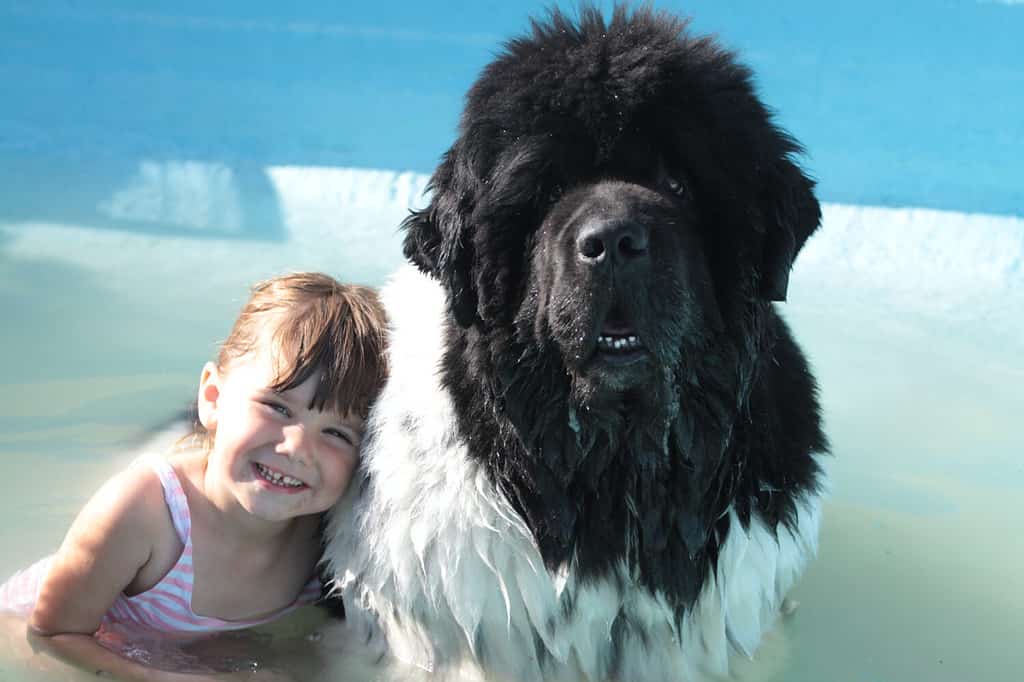
The Newfoundland’s calm, affectionate nature allows them to fit seamlessly into family life, and they are generally good with children and other pets.
©Da Silva Emmanuelle/Shutterstock.com
Living Environment: Siberian Husky
In contrast, Siberian huskies have specific needs regarding their living environment. These energetic, athletic dogs require ample space to roam and play, making a large, securely fenced yard essential for their happiness and safety. Siberian huskies are known for their exceptional escape skills, so ensuring proper containment is vital.
Additionally, they are highly social animals and thrive in environments where they can interact with their human family members and other dogs regularly. Like Newfoundlands, Siberian huskies prefer cooler climates due to their dense double coats, so providing them with a comfortable, temperature-controlled living space is essential.
Nutrition
Nutrition: Newfoundland
Newfoundlands need balanced diets to sustain their large, muscular frames. High-quality proteins, like chicken or fish, support muscle maintenance. At the same time, healthy fats, such as omega-3 fatty acids, promote coat health and joint function.
Nutrition: Siberian Husky
Siberian huskies, being athletic, require different nutritional profiles. Lean proteins, such as turkey or fish, fuel their energetic lifestyles, while complex carbohydrates, like sweet potatoes or brown rice, provide lasting energy without adding excess weight.
Embracing the Ideal Companion: Newfoundland vs. Siberian Husky
In this journey through the 9 key differences between Newfoundlands and Siberian Huskies, we’ve uncovered the unique attributes that make each breed special. Your circumstances, lifestyle, and preferences will guide you in selecting the perfect companion.
In conclusion, the Newfoundland and Siberian husky each bring unique traits and charms. From the Newfoundland’s gentle and affectionate nature to the Siberian husky’s playful and adventurous spirit, both breeds offer distinct qualities that can enrich the lives of their owners.
Understanding the nine critical differences highlighted in this comparison allows for informed decisions when considering these breeds as companions. Whether you’re drawn to the Newfoundland’s gentle giant allure or the Siberian husky’s boundless energy, embracing these differences will ensure a fulfilling and rewarding relationship with your chosen four-legged friend.
The photo featured at the top of this post is ©
Ready to discover the top 10 cutest dog breeds in the entire world?
How about the fastest dogs, the largest dogs and those that are -- quite frankly -- just the kindest dogs on the planet? Each day, AZ Animals sends out lists just like this to our thousands of email subscribers. And the best part? It's FREE. Join today by entering your email below.
Thank you for reading! Have some feedback for us? Contact the AZ Animals editorial team.







